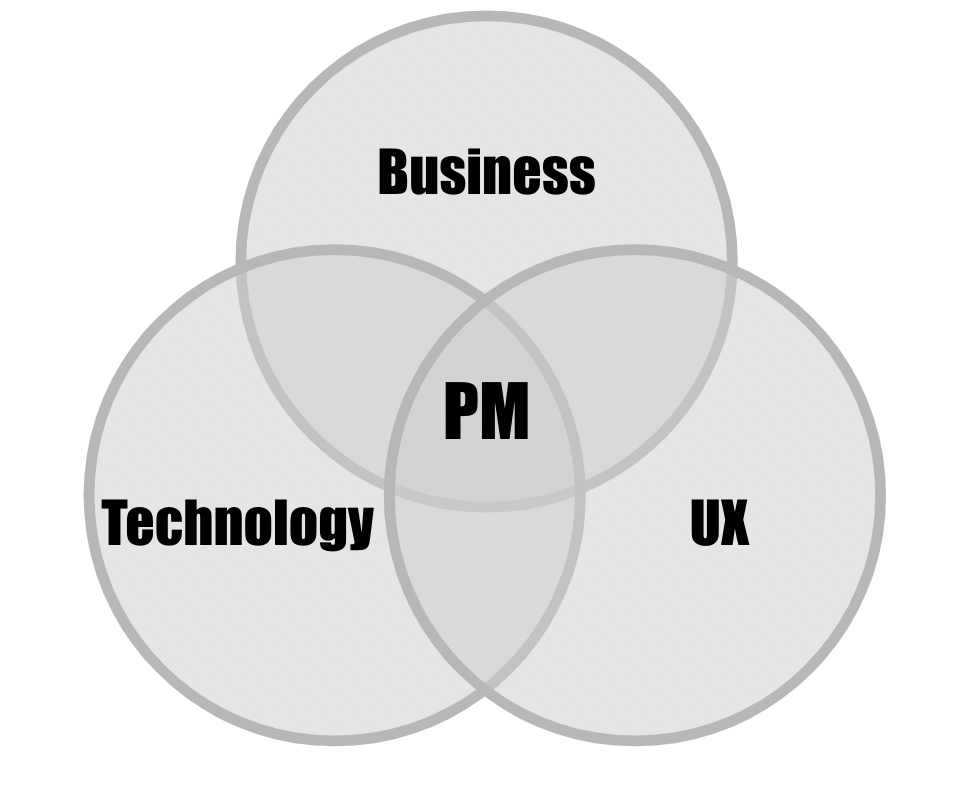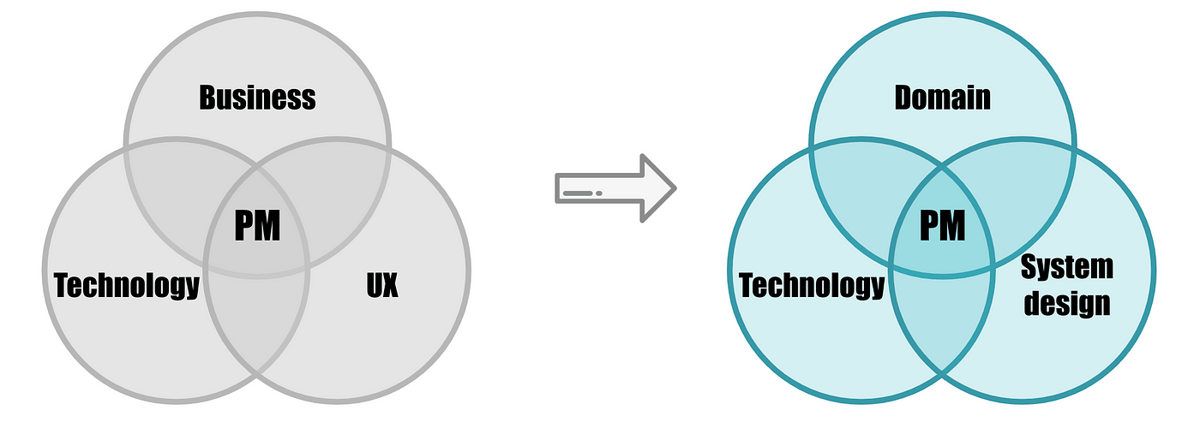Understanding the shift in product management roles
The decline of traditional product management
There’s been a noticeable trend in the tech industry: traditional product management (PM) is giving way to technical product management. According to Glassdoor, technical PMs’ average salary in 2023 is $155k, while it is $132k for traditional PMs. Becoming a technical PM is clearly the new gold standard for product management.
Having witnessed this trend firsthand during my 10+ years in tech and AI, I’d like to shed some light on the differences between traditional PMs and technical PMs and offer guidance for those interested in becoming a technical PM.
Many of us are familiar with Martin Eriksson’s Venn diagram for product managers, balancing business, technology, and UX. However, this model is becoming outdated for technical PMs.

Previously, a “product” was assumed to be a tangible, interactive entity with established business value. However, today’s products might be extremely tech-centric and entirely intangible without much requirement on business or UX, such as breakthrough machine learning algorithms or complex API gateways.
Here are a few key sectors where technical PMs are increasingly needed than traditional PMs. This is not an exhaustive list but it gives an idea on the sectors that are experiencing the shift.
- Machine learning innovations such as Large Language Models
- Advanced robotics, such as autonomous vehicles and surgical robots
- Space technologies
- Brain-computer interaction technologies
- Biotechnology
Differences between traditional and technical product management
- Nature of product: Technical product managers (TPMs) tend to work on innovative tech products, often without a clear precedent.
- Stakeholders they collaborate with: While traditional PMs work with UX designers and business analysts, TPMs typically work more with engineers and researchers.
- Skill set: TPMs must understand the technical construct of their products, enabling them to make informed decisions without the constant need to defer to engineers, whereas traditional PMs are more user-centric and spend less time on technical aspects.
What has caused the rise of TPMs?
A few observations:
- Growing complexity of tech products: AI products, for instance, have distinct demands.
- Role overlap: Engineers and data scientists today are increasingly acquiring skills traditionally associated with PMs, blurring the lines between their roles
- Advancements in PM tools: Many tools now simplify tasks once central to the traditional PM’s role. For example, there are advanced workflows and data insights that can be done automatically without relying on a PM.
New Venn diagram for technical product management
Given these nuances, I propose a fresh Venn diagram for TPMs: Domain knowledge, technical knowledge, and system design knowledge.

- Domain knowledge: This circle replaces the traditional business circle. A successful TPM must understand the subject area very well, ensuring the technology addresses specific pain points.
- Technical knowledge: TPMs must have a genuine understanding of technical best practices beyond merely using technical jargon. They should foresee potential technical bottlenecks and have a strong sense of solving technical problems. A lack of this understanding can result in unrealistic product goals and unavoidably conflicts with engineers.
- System design knowledge: Moving past user-centric design, TPMs need to plan and visualize how various technical components interplay and depend on each other. This is particularly vital due to product complexity.
Let me use an example to dive deeper into how this new Venn diagram works: Autonomous navigation systems in robotics.
- Domain knowledge: TPMs must understand that navigation quality is tied to sensor quality and the fusion algorithms. Additionally, they must keep up with tech trends, like choosing between a camera-only sensing suite or incorporating LiDARs, and keeping up with regulatory requirements such as permits and traffic rules.
- Technical knowledge: TPMs should have a high-level understanding of major algorithms, their pros and cons, limitations of different sensors and HD maps. Leverage these insights to make informed decisions and set realistic targets.
- System design knowledge: System design thinking is crucial for TPMs building autonomous navigation systems. This includes determining whether to run something on cloud, how to capture reliability, or how to optimize for performance.
How to become a technical product manager?
Considering transitioning to a TPM role? Here are a few tips:
- Go deep. Learn tech basics but make sure to pick a domain and go deep. Understand key technical challenges in that domain and eventually become the go-to expert.
- Hone fundamental skills. For example, if your focus is machine learning (ML), learn how to read ML papers efficiently. Be able to sketch simple technical diagrams and convey technical concepts in plain language.
- Learn engineering best practices such as continuous integration, version control, modularity, and documentation. These are the universal rules for almost every technical development. What’s the difference between a prototype for research and a production level solution?
- Join a tech-oriented team. Immerse yourself in a technical culture. Partner with an experienced engineering buddy to get you up to speed. Get hands-on. Learn as you go.
Challenges to anticipate in technical product management
Though TPMs get to work on many cool projects, there are a few common challenges you should also consider.
- Navigating tech-first environments: In teams led by engineers, it can be hard to make an impact as someone without a PhD in tech. Top-level decisions are typically made by engineers instead of business people. Therefore, TPMs must learn how to steer product directions with a strong business sense. Educate your team on how to incorporate business strategy into decision making.
- Balancing between technical depth and product vision: Here is a challenge related to the first one. TPMs must understand the technical nuances of their products but can sometimes get too deep into the details, losing sight of the broader product strategy or user needs.
- Balancing between soft Skills and technical skills: One must not forget to develop soft skills while focusing on technical skills. Regardless of which type of PM you are, you have to be good at communication, stakeholder management, ownership, time management, etc.
Conclusion
Transitioning to a TPM role is a process. It can even be a mindset shift. In my own journey, embracing the technical aspects of product management opened doors to opportunities I never imagined.For those of you eager to contribute at this intersection of tech and product, TPM definitely offers an exciting and impactful opportunity.
How do you see the role of traditional product management evolving in your sector? What skills do you believe will be most crucial for the technical PMs of tomorrow? Feel free to drop a line on my LinkedIn and let’s discuss. https://www.linkedin.com/in/charlottetao/


